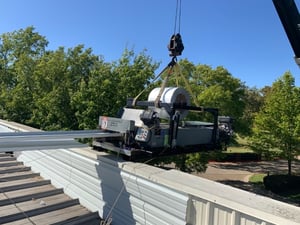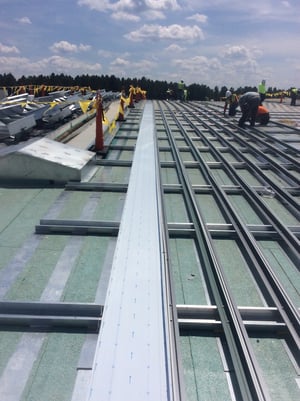Rollforming Long Standing Seam Metal Roof Panels Onsite
Manufacturing and transportation limitations often require panels above 60' to be spliced. Yet panel end laps represent the primary weakness in metal roofing systems.
However, roll forming and lifting technology advancements now allow some manufacturers to produce single-piece continuous panels exceeding 250 feet in length onsite.
 Benefits of Onsite Panel Production:
Benefits of Onsite Panel Production:
- Improved Weather Tightness: Single-piece panels eliminate end laps, which are prone to leaking caused by the expansion and contraction of roof panels. With panel lengths up to 250', running a single-piece panel eliminates this problem.
- Reduced Leaks/Callbacks: Onsite production minimizes human error during end-lap installations, reducing potential leaks.
- Efficient Installation: Lap details are incredibly time-consuming for installation crews. Single-piece panels speed up the installation process, thereby reducing the occupancy schedule.
- Lower Transportation Costs: Shipping coils instead of finished panels allows for more weight per truck, resulting in fewer trucks and reduced carbon footprint. Architectural panels are typically created during the loading process to prevent in-transit damage. Consequently, we end up shipping a lot of "air" with our panels. When coils are shipped instead, we can put 40,000 lbs. + of actual material on the truck instead of 20,000-25,000 lbs. of material when delivering roll-formed panel goods. On bigger jobs, this alone can save the customer the labor and associated freight costs of several additional trucks.
- Minimal Onsite Storage: Onsite panels are typically produced and stored on the rooftop, eliminating ground storage challenges. In contrast, panels produced in manufacturing environments are delivered to the site and offloaded to the ground. Storing roof panels on the ground can be challenging for sites with a smaller footprint or those with lots of other storage needs.
- Decreased Damage: Producing panels onsite virtually eliminates the potential for panel damage in transit from the manufacturing facility to the job site.
- Reduced Packaging: Onsite-produced panels don't require extensive wood crating, reducing material and labor costs. When panels are factory-produced, installation crews spend considerable time tearing down crates and getting the crating material back to the ground as they install the panels. When panels are job site produced, the often excessive wood crating is unnecessary. Panels are simply run onto the roof, stacked, and tied off as appropriate until it's time to begin panel installation.
 Considerations for Onsite Production:
Considerations for Onsite Production:
1. Eave Height: Some manufacturers experience eave height limitations of around 30' for onsite production. Always check with your manufacturer for any limitations before planning for onsite panel production.
2. Hoisting: Proper equipment is needed to hoist the rollforming machines to the roofing level.
3. Space: A sufficient turning radius and overhead clearance are essential for equipment placement and safety.
4. Safety: It's crucial to include measures like fall prevention, machine guards, and personal protection equipment in your onsite manufacturing plan.
5. Manpower: Longer panel lengths demand more workforce. Typically, each 15-foot of panel requires one laborer.
6. Machine Quality/Training: Quality of tooling and operator experience significantly affect the panels' quality.
7. Weather: Adverse conditions like high winds, extreme temperatures, or rain can hamper onsite production.
Warning!
Cheap, low-quality portable machines produce poor-quality metal roof panels. The tooling we take to job sites is the same quality we use in our manufacturing facilities. Do not expect the results described above without the best-quality roll-forming equipment.
While onsite panel production demands specific equipment and meticulous planning, its benefits make it a viable option for large-scale roofing projects that desire a 60 + year service life. Before opting for onsite production, it's critical to vet both the installer and manufacturer based on their experience with similar projects.
About McElroy Metal
Since 1963, McElroy Metal has served the construction industry with quality products and excellent customer service. The employee-owned components manufacturer is headquartered in Bossier City, La., and has 14 manufacturing facilities across the United States. Quality, service and performance have been the cornerstone of McElroy Metal’s business philosophy and have contributed to the success of the company through the years. As a preferred service provider, these values will continue to be at the forefront of McElroy Metal’s model along with a strong focus on the customer.



.png?width=767&name=What%20to%20Expect%20When%20You%20Order%20From%20McElroy%20Metal%20(1).png)


.png?width=440&height=293&name=How%20to%20Install%20Metal%20Roofing%20Over%20Existing%20Metal%20Roofs%20(1).png)


Comments on this article:
Scroll down to the bottom to submit a comment and join the conversation. Need help or have a question? Please contact us. Looking for a distributor or contractor? Please click here to get started.